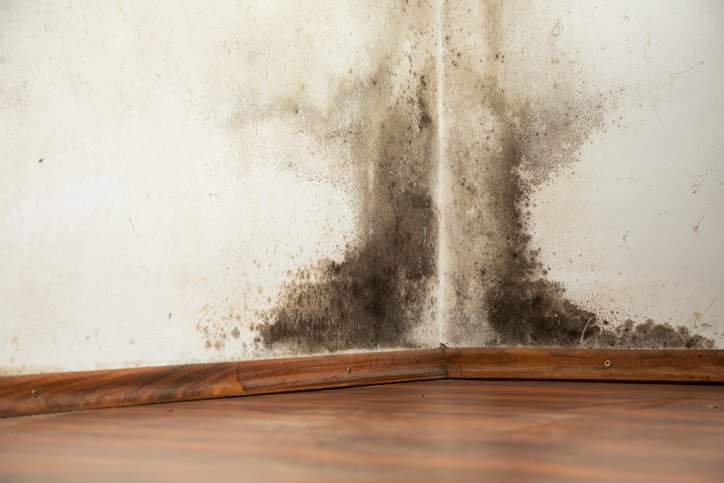
What is black mold? Is all black mold toxic? What does black mold look like? How common is black mold? Unfortunately, you may find yourself asking these questions at some point, and a quick internet search can often result in a lot of conflicting (and overwhelming) information.
In this guide, we tackle the facts and myths when it comes to black mold so that you and your family are prepared. Plus, we offer tips for identifying black mold and what you should do if you find it in your home.
10 Facts About Black Mold
7 Myths About Black Mold
How To Tell If You Have Toxic Black Mold
What Is Black Mold Poisoning?
How To Treat Black Mold Poisoning
How Does Black Mold Grow and Spread?
How to Remove Black Mold
10 Facts About Black Mold
Before we examine the top myths, let’s first discuss what black mold actually is, where you can commonly find it in your home, and how it differs from other types of mold.
1. Stachybotrys chartarum, also commonly known as black mold, is a toxic type of fungus/growth.
2. This type of mold typically results from a continuous water leak over an extended period of time.
3. There is no one particular type of black mold since many types have a similar color. When people say, “black mold,” they are typically referring to Stachybotrys chartarum, according to Medical News Today.
4. Stachybotrys chartarum is actually a greenish-black mold, according to the CDC.
5. It can grow on materials with a high cellulose content, such as fiberboard, gypsum board, and paper, according to the CDC.
6. This type of fungus requires 100% water saturation and constant moisture in order to thrive — as opposed to other forms of mold that only require high levels of relative humidity.
7. Exposure to black mold can cause a number of adverse health conditions, including:
- Chronic coughing and sneezing
- Irritation to the eyes and mucous membranes of the nose and throat
- Rashes
- Fatigue
- Persistent headaches
- Nausea
- Vomiting
- Bleeding in the lungs and nose
8. Your doctor can check for mold allergies by with a blood test and spin prick test. “Your doctor takes a blood sample and then sends it to a laboratory to measure the number of certain antibodies, which can indicate your immune system’s sensitivity to different mold species,” according to Healthline. If you are experiencing any adverse health effects that you believe are related to mold, it’s best to consult your primary care provider.
9. All types of mold, include black mold, may cause “health symptoms that are nonspecific,” according to the CDC.
10. The best way to prevent black mold growth is to control moisture and humidity.
7 Myths About Black Mold
Myth #1: Black mold is known to cause heart problems.
Truth: There is no test that proves an association between Stachybotrys chartarum and particular heart symptoms, according to the CDC.
Myth #2: Black mold should be treated differently than other types of mold.
Truth: All molds have the potential to cause health problems, which means you should remove any type as soon as possible.
Myth #3: There is a link between black mold and acute idiopathic hemorrhage.
Truth: “To date, a possible association between acute idiopathic pulmonary hemorrhage among infants and Stachybotrys chartarum has not been proven. Further studies are needed to determine what causes acute idiopathic hemorrhage,” according to the CDC.
Myth #4: You can completely eradicate all mold from your home.
Truth: Mold is all around us in healthy levels. The goal of mold remediation, or removal, is to bring the mold spore count to what’s called “a normal ecology level” and eliminate the reasons unhealthy levels of mold are happening in the first place.
Myth #5: All black mold is toxic.
Truth: Not necessarily. Mold comes in a variety of colors, including black, but not all black mold is Stachybotrys chartarum, which is toxic — and typically what people refer to when they say black mold. Plus, all types of mold exposure can be harmful in the right conditions.
Myth #6: If I have a small amount of black mold, I can take care of it myself.
Truth: No matter how much mold you have in your home, proper remediation from a reputable mold contractor is strongly recommended. You want to ensure all the mold is safely and properly removed, which can be difficult to do without the right training, knowledge, and equipment.
Myth #7: Once it’s gone, black mold will never come back.
Truth: As if the case with all types of mold, the only way to prevent future growth is to control moisture and humidity.
How To Tell If You Have Toxic Black Mold
Sometimes homeowners incorrectly assume they have black mold, but not all black mold is Stachybotrys chartarum.
Stachybotrys chartarum, however, is usually fluffy, whereas some of the other types of molds are flat and won’t wipe away.
The bottom line, however, is that mold should be removed, no matter its color.
The best way to verify the type of mold is to call a mold remediation company. Air sampling may also be required.
What Is Black Mold Poisoning?
Black mold poisoning is also known as stachybotryotoxicosis: “A serious and sometimes fatal intoxication chiefly affecting domestic animals (as horses) that is due to ingestion of a toxic substance produced by mold (Stachybotrys chartarum).”
Popular home and garden channel HGTV points out that the symptoms for black mold poisoning and black mold exposure may be the same, including chronic coughing and sneezing, irritation to the eyes and mucus membranes of the nose and throat, chronic fatigue, constant headaches, and rashes.
How To Treat Black Mold Poisoning
If you, your family, or your pets are experiencing any symptoms related to black mold exposure or poisoning, it’s important to visit your health care provider for the best course of action.
It’s equally important to avoid the contaminated area and have a remediation company remove the mold as soon as possible.
How Does Black Mold Grow and Spread?
Black mold requires 100% water saturation and constant moisture in order to thrive. It’s commonly found in areas with water damage, water leaks, condensation, water infiltration, or flooding, according to the CDC.
How to Remove Black Mold
The first step is contact a reputable mold remediation company. They will then identify and locate the source that allowed the mold to grow in the first place and then form a detailed strategy for removal.
It depends on the contractor’s workload, but the entire process from the initial phone call to complete removal could take place within one week.
The contractor will remove the black mold through one of numerous methods, such as:
- Eliminating impacted materials
- Using chemicals and dry ice treatments
- Dehumidification
- Using hydroxyl generators
- Applying mold-resistant coatings
The process for removal is generally the same no matter what type of mold you have in your home. Most importantly, the only way to prevent future mold growth is to correct the situation that created the mold in the first place, so your contractor will likely discuss this with you to prevent any further problems.
Do You Have Black Mold? We Can Help!
Black mold is a serious problem. If you think you have it in your home — or if you have any questions — please give us a call. We’re also happy to come out and inspect the area in question, free of charge!
As an industry leader with more than 35 years of award-winning experience, EnviroVantage specializes in indoor air quality improvements, mold remediation, asbestos abatement, duct cleaning, and more. We have helped thousands of homeowners eliminate problems in their home, including all types of mold.
Contact us today for more information!

Are you ready to buy or sell your home?
Whether your offer has just been received or you’re thinking about putting your house up for sale, consider these 15 important questions to ask your home inspector.

Questions?
We’d be happy to answer them — and talk about how EnviroVantage can support your next abatement, demolition, or remediation project.